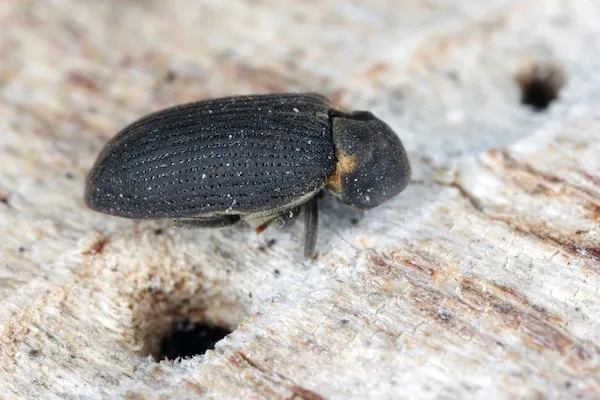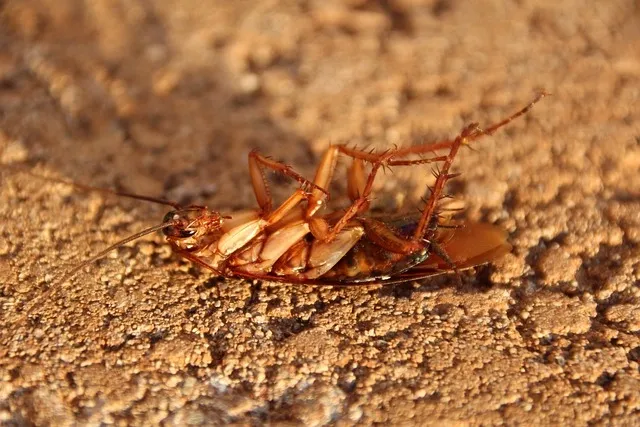In pest control, precise identification is the key to effective management. The difference between a brown recluse and your run-of-the-mill house spider can save you stress, worry, and a hefty medical bill!
Beyond these creepy crawlers, Missouri’s diverse ecosystem also hosts a myriad of beetles that inhabit your gardens, yards, and even homes. However, many of these pesky insects closely resemble another dreaded indoor pest: roaches.
Mastering the art of identification can help you distinguish these beetles that look like roaches from their other invasive counterparts. Join us as we give you the rundown on many common Missouri beetles and how you can tell these pests apart from roaches!
Understanding the Difference of Beetles That Look Like Roaches
Identifying beetles that resemble roaches in Missouri can be tricky, especially for those not well-versed in entomology. However, upon closer inspection, unique characteristics emerge that set them apart.

Wood-Boring Beetles
Wood-boring beetles, including species like the Anobiidae family, are often found in wooden structures or decaying wood. Their appearance, with an elongated body and dark coloration (brown or black), can cause confusion with certain roach species.
These beetles lay their eggs in wood, allowing the emerging larvae to feed on and damage wooden structures. Unlike roaches, they don’t pose health risks to humans but can be detrimental to wooden materials in homes if left unchecked.
Darkling Beetles
Darkling beetles, a type of ground beetle from the Carabidae family, can resemble roaches due to their dark coloration and somewhat similar body shape. These beetles are beneficial predators, often preying on other insects and pests in gardens or outdoor environments.
Occasionally, they might wander indoors, especially in damp conditions or around poorly sealed entry points. Unlike roaches, they do not infest food sources or pose significant health threats to humans.
Blister Beetles
Blister beetles have a unique defense mechanism—they release substances that can cause skin irritation or blisters on contact. These beetles usually hang out in fields, gardens, or on flowering plants, munching on plant material.
Despite their similar appearance to common roach species, blister beetles don’t sneak into homes and aren’t a direct threat to human health indoors.
Effective pest management relies on understanding the habits and habitats of beetles resembling roaches. These insects often share environmental preferences, making it challenging to distinguish between them.
Wood-boring beetles, for instance, tend to inhabit decaying wood or damp areas, favoring locations similar to roaches, such as humid basements, kitchens, and areas with moisture. This similarity in preferred environments complicates their accurate identification.
Additionally, ground beetles, resembling roaches in appearance, commonly reside in outdoor spaces like gardens, under rocks, and among leaf litter. While their presence outdoors benefits the ecosystem, their occasional movement indoors can alarm homeowners, who mistake them for roaches.
Differentiating Features
Although these beetles share similarities with roaches, specific distinguishing characteristics help differentiate between the two, aiding in precise identification:
Antennae: Beetles generally have shorter and sturdier antennae compared to the long and delicate ones of roaches, which serve as sensitive receptors for roaches to detect their surroundings more precisely.
Elytra and Wings: Beetles have elytra, which are hardened forewings protecting their delicate hind wings. In contrast, roaches have flat wings over their bodies that lack this dual-wing structure.
Body Shape and Color: While some beetles may resemble roaches in size and color, their body shapes often differ. Roaches typically have a flatter body, while beetles may be more elongated or rounded.
Behavioral Patterns: Beetles tend to scuttle quickly and may exhibit predatory behavior, engaging in hunting or foraging activities. Conversely, roaches usually scurry away from light sources and exhibit nocturnal behavior, preferring dark and hidden areas.
Control Measures Against Beetles That Look Like Roaches
Effective pest control strategies rely on accurate identification and targeted interventions. Once correctly identified, managing these beetles requires a combination of preventive measures and professional assistance:
Sanitation: Consistent and thorough cleaning routines are pivotal to deter beetle infestations. Regular vacuuming, sweeping, and dusting help eliminate food sources and hiding spots that may draw these pests indoors.
Sealing Entry Points: Beetles often find their way indoors through tiny cracks and openings in walls, windows, and doors. Sealing these entry points with caulking or weather stripping reduces the likelihood of beetle intrusion and limits their access to the house’s interior.
Moisture Control: Addressing moisture-related concerns is crucial in beetle prevention. Identifying and repairing leaks in plumbing or roofing, ensuring proper drainage, and using dehumidifiers in damp areas like basements and crawl spaces significantly reduce favorable conditions for beetle infestations.
Professional Assistance: Pest control professionals conduct thorough inspections to identify potential entry points, locate infestation sources, and assess the extent of the beetle or roach problem. They provide tailored management plans that may include targeted treatments and proactive measures to prevent future infestations.
If you have a beetle or roach infestation in your Missouri home, give us a call here at Absolute Pest Control! We cover many areas in the Kansas City Metro and are proud to eliminate any of those pesky insects taking over your home. Get in touch with us today!

